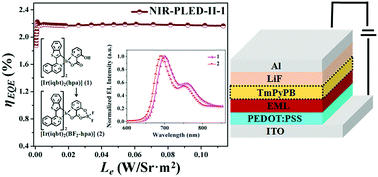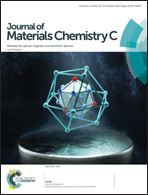Efficient near-infrared (NIR) polymer light-emitting diodes (PLEDs) based on heteroleptic iridium(iii) complexes with post-modification effects of intramolecular hydrogen bonding or BF2-chelation†
Abstract
In heteroleptic iridium(III)-complexes capable of near-infrared (NIR) emitting, elaboration of their ancillary ligands is under-explored. In this study, through OH-modification at the 3-position of the picolinato (pic) ancillary ligand, we report two new complexes [Ir(iqbt)2(hpa)] (1; Hiqbt = 1-(benzo[b]-thiophen-2-yl)-isoquinoline; hpa = 3-hydroxypicolinate) with intramolecular hydrogen bonding and [Ir(iqbt)2(BF2-hpa)] (2) with further BF2-chelation, exhibiting desirable NIR luminescent properties (λem = 700 nm with a shoulder at 760 nm, lifetime τ = 2.13 μs and quantum yield ΦPL = 0.13 for 1versus λem = 692 nm with a shoulder at 756 nm, lifetime τ = 0.76 μs and quantum yield ΦPL = 0.08 for 2) in their respective solutions at RT. Moreover, two series of solution-processed NIR polymer light-emitting diodes (PLEDs-I-II) are fabricated from these two complexes, either in the presence or absence of a TmPyPB-assisted (TmPyPB = 1,3,5-tri[(3-pyridyl)-phen-3-yl]benzene) carrier balance, where a superior performance (ηmaxEQE = 2.22% and almost negligible efficiency-roll-off) is obtained for complex-1-doped NIR-PLED-II, with particular respect to facilitated electron transport.



 Please wait while we load your content...
Please wait while we load your content...
